Tuesday, September 28, 2010
Cottonwood CG, Canyon de Chelly Natl Mon - May 28-June 1
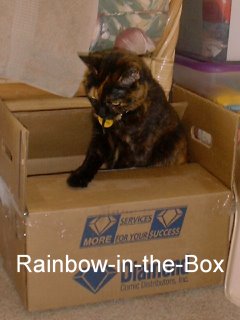 This is a "no fee" campground (no water or electric) with a 5-day limit that is mainly enforced when the campground fills up. Most of the sites are smallish, and there are only 4 or 5 really good solar sites. We were able to get one with full sun all day, which had its good side (battery well-charged every day) and its bad side (95+ temps outside and in). Every day we would return from sightseeing and find the cats stretched out as L-O-N-G as they could make themselves. Rainbow keeps ducking into a cardboard box, hoping no doubt that she'll be mailed to Alaska!
This is a "no fee" campground (no water or electric) with a 5-day limit that is mainly enforced when the campground fills up. Most of the sites are smallish, and there are only 4 or 5 really good solar sites. We were able to get one with full sun all day, which had its good side (battery well-charged every day) and its bad side (95+ temps outside and in). Every day we would return from sightseeing and find the cats stretched out as L-O-N-G as they could make themselves. Rainbow keeps ducking into a cardboard box, hoping no doubt that she'll be mailed to Alaska!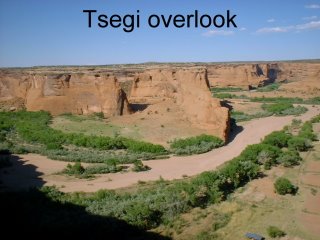 Canyon de Chelly is actually two main canyons, Canyon de Chelly (Chelly being an Anglicization of the Spanish attempt to spell "tseyi", the Navajo name meaning "in the rock") and Canyon del Muerto, named for the number of Anasazi remains found there. The canyons are filled with thousands of Anasazi ruins, and extensive rock art.
Canyon de Chelly is actually two main canyons, Canyon de Chelly (Chelly being an Anglicization of the Spanish attempt to spell "tseyi", the Navajo name meaning "in the rock") and Canyon del Muerto, named for the number of Anasazi remains found there. The canyons are filled with thousands of Anasazi ruins, and extensive rock art.  The Navajo consider this land their native homeland, even though the Anasazi lived here before them. Except for one hike, visitors are not allowed unescorted into any of the canyons. Scenic drives take you to 4 impressive overlooks of Muerto, and 8 equally wonderful overlooks of Chelly. We attended several ranger talks at the campground, which mainly focused on the history of the Navajo people.
The Navajo consider this land their native homeland, even though the Anasazi lived here before them. Except for one hike, visitors are not allowed unescorted into any of the canyons. Scenic drives take you to 4 impressive overlooks of Muerto, and 8 equally wonderful overlooks of Chelly. We attended several ranger talks at the campground, which mainly focused on the history of the Navajo people. 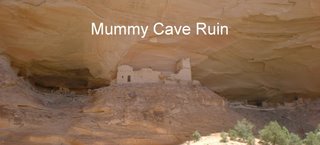 In the 1800s there were many attempts to subdue the Navajo, until Kit Carson led a campaign of several years, finally starving the Navajo out of their last hiding place, Canyon de Chelly. After the Navajo surrendered in 1864, 8500 were marched in groups across 400 miles of mountain & desert to Fort Sumner, NM.
In the 1800s there were many attempts to subdue the Navajo, until Kit Carson led a campaign of several years, finally starving the Navajo out of their last hiding place, Canyon de Chelly. After the Navajo surrendered in 1864, 8500 were marched in groups across 400 miles of mountain & desert to Fort Sumner, NM. 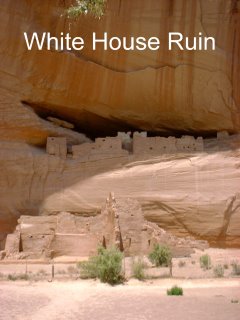 Many died on this "long walk" and more soon after. Finally, on June 1, 1868, the survivors signed a treaty, allowing them to return to their homelands. Since 1931, the NPS has administered the 130 square miles of the Natl Mon for the Navajos who still farm the canyon in the summer.
Many died on this "long walk" and more soon after. Finally, on June 1, 1868, the survivors signed a treaty, allowing them to return to their homelands. Since 1931, the NPS has administered the 130 square miles of the Natl Mon for the Navajos who still farm the canyon in the summer.Doug joined the weekly ranger-led hike into the canyon (Willie had hip problems while hiking near Winslow, and was uncertain about hiking with a group). A certain lack of organization led to a late (9:30) start, and to a heat-of-the-day (1:30) climb out.
 The new hydration pack, however, worked like a champ, and being able to see numerous ruins and rock art close up was truly wonderful.
The new hydration pack, however, worked like a champ, and being able to see numerous ruins and rock art close up was truly wonderful.We both went on an all-day Navajo-led "jeep" tour of the canyons -- the jeep being a modified Korean War vintage 6-wheel-drive personnel carrier (Unimog).


The driver (a Navajo who seemed to enjoy "working the crowd") stopped at all major ruins, as well as some good rock art, ending with a stop at Spider Rock, an 800-foot tall twin spire of sandstone. Spider Rock was named because the first weaver who lived there was called Spider Woman.
The next day we drove to Hubbell Trading Post Natl Historic Site, begun in 1876 and still an active trading post. Trading posts were social centers of the Navajo Nation, where no formal communities existed, and Hubbell, while becoming wealthy transacting with the Navajo, served as their liaison to the outside world, translating and writing letters, settling family quarrels, and explaining government policy.

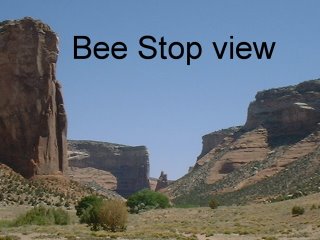 When a smallpox epidemic swept the reservation in 1886, he worked day and night caring for the sick and dying, using his own home as a hospital. Hubbell sold the land, buildings & contents to the NPS for a very reasonable sum, on the condition that they would always maintain a trading post there. We were just in time for a guided tour of the old house, which contains so many valuable works of art (paintings, drawings, baskets, rugs & pottery) that there is a curator on staff. Our guide, a very young appearing Navajo grandmother, shared her interesting views on combining the Navajo culture with modern US culture.
When a smallpox epidemic swept the reservation in 1886, he worked day and night caring for the sick and dying, using his own home as a hospital. Hubbell sold the land, buildings & contents to the NPS for a very reasonable sum, on the condition that they would always maintain a trading post there. We were just in time for a guided tour of the old house, which contains so many valuable works of art (paintings, drawings, baskets, rugs & pottery) that there is a curator on staff. Our guide, a very young appearing Navajo grandmother, shared her interesting views on combining the Navajo culture with modern US culture.
 We hope those of you also experiencing this early heat wave have lots of electricity to run your air conditioners! Unfortunately, it is not possible to carry enough batteries & solar panels to operate a/c. However, at least we have the cooler nights of the dry desert climate. We will be moving to a slightly cooler climate tomorrow. The cats, who are all doing well now, will be pleased. And we have promised them electricity in case we need the a/c.
We hope those of you also experiencing this early heat wave have lots of electricity to run your air conditioners! Unfortunately, it is not possible to carry enough batteries & solar panels to operate a/c. However, at least we have the cooler nights of the dry desert climate. We will be moving to a slightly cooler climate tomorrow. The cats, who are all doing well now, will be pleased. And we have promised them electricity in case we need the a/c.